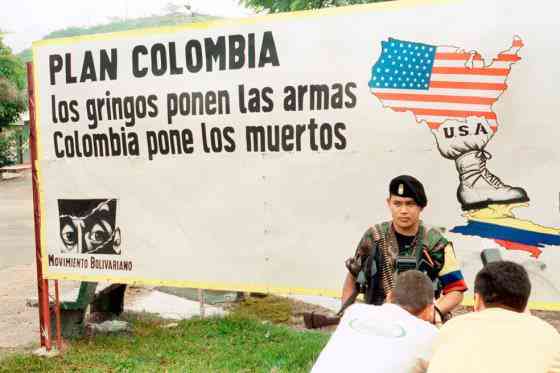The Future of the Colombian Civil War

April 23, 2018
For most Americans, it is a simple fact of life that most of us can’t name all the countries that the United States is currently involved in, as the list stretches from Africa to Europe to the Pacific. With that being said, the topic of American foreign intervention in Latin America is hardly discussed at any meaningful depth, and this problem persists at Vanderbilt. Here, most discussions are confined to the Department of Latin American Studies, despite the fact that the history of American involvement in the Southern Hemisphere is of immense importance to many areas of study, including economics, public policy, history, statistics, and literature. One of the most overlooked international projects is our seventeen-year foreign policy package: Plan Colombia, which seeks to alleviate the flow of cocaine into the United States. Understanding Plan Colombia gives us a key avenue into piecing together the complex web of American foreign policy in Latin America, and the impact it has had on the image of the United States abroad.
The ongoing civil war in Colombia is a conflict between the Colombian government, numerous radical right-wing paramilitary groups, and the insurgent leftist Colombian Armed Revolutionary Forces (FARC). FARC was conceived during the period of civil unrest in the 1960’s, particularly as a response to the suppression of indigenous and rural voices in government and the violence perpetrated against them. In 1964, Manuel Marulanda, a member of the Colombian Communist Party, partnered with Jacobo Arenas to form a community in which the voice of the rural population would be heard. The group set up base in the small community of Marquetalia, about 150 miles away from Bogotá, the capital.
However just two years prior, the United States launched Plan Lazo, a counterinsurgent strategy designed to quash any sign of Communism in Colombia. The United States authorized select military personnel to execute paramilitary attacks, in cooperation with the Colombian military, against any communist faction in Colombia, and in May of 1964, the Colombian military attacked Marquetalia. Of the 1,000 inhabitants of the region, only 48 were armed. Following the attack, the surviving fighters met with other communities in what became known as the First Guerilla Conference and formed the Southern Bloc, a primarily defensive military insurgency vowing to defend the small communist community surrounding Marquetalia.
At this conference Marulanda cemented his position as a community revolutionary dedicated to overthrowing the Colombian state. The Southern Bloc emerged with limited resources but a fierce Marxist ideology. Two years later, at the Second Guerilla Conference, the Southern Bloc renamed itself the Fuerzas Armadas Revolucionarias de Colombia and repositioned its strategy from defense to recruiting militants for combat and carrying out attacks against the Colombian government. Aiming to expand rather than defend, FARC radically shifted its position relative to the government. In this fashion that a renegade communist, positioned in a remote rural community outside Bogotá, formed the oldest and perhaps deadliest guerrilla group in contemporary history.
In FARC’s early years, the group slowly expanded southward into more rural communities. FARC insurgents frequently recruited children and poor farmers and trained them in tactical guerilla warfare. In order to fund its activities, FARC began kidnapping and ransoming politicians and their family members. As membership increased and FARC began positioning itself as a prominent regional power, members turned to cocaine trafficking to supplement these ransom funds. The global drug trade boomed in the late 1970s and early 1980s, and coca farming in Colombia became increasingly lucrative. Soon many poor farmers shifted from licit crop production to coca to provide for their families. With increased funds and military power, membership skyrocketed, and by the early 1990s, FARC recruited nearly 20,000 guerilla fighters. At the same time, radical paramilitary groups, including the National Liberation Army (ELN) began exerting their influence in the countryside, often in conflict with FARC. Such groups often also used illicit avenues of funding and routinely attacked government infrastructure. The Colombian government was soon dragged into conflict in an effort to maintain the rule of law, crack down on increased narco-trafficking, and stem the violence.
The resulting civil war has dragged on for fifty years, and in its path has claimed over 250,000 lives and displaced 7 million people, which, according to the United Nations, is the highest number of internally displaced people in the world. Paramilitary groups and FARC insurgents regularly employed scare tactics to consolidate power, torturing and slaughtering entire rural communities. Colombia soon became the most dangerous place in the world for trade-unionists, who were often targeted and murdered. Unfortunately, many military officials had ties with radical paramilitary groups and encouraged impunity. The civil war in Colombia is arguably one of the most overlooked conflicts in the world, frequently escaping the media cycle.
This is where the United States comes in. In 2000, the United States launched Plan Colombia, a sweeping set of policies intended to crack down on violence and drug proliferation in Colombia. After more than $10 million spent over the last 17 years, this set of policies has achieved remarkably little, and this failure lies in the very goals of the plan. At its heart, Plan Colombia was marketed to the American public as a crackdown on drugs. Instead of addressing the rural poverty and other related causes of conflict, Plan Colombia focused most of its efforts on direct military intervention and seizure of cocaine to appease American taxpayers. Under Plan Colombia, the American military aided Colombian security forces which had clear and unequivocal links to the coercive paramilitary groups that greatly contributed to the bloodshed. In one instance, USAID funded the company Copoagrosur, which at the time was under control of a paramilitary chief who has confessed to 4,000 civilian murders. This lack of accountability under Plan Colombia has, according to a study conducted by Oeindrilla Dube and Suresh Naidu, contributed to 138% more paramilitary attacks per year in regions receiving funding under Plan Colombia. The plan, rather than promoting peace, invigorated conflict and increased anti-American sentiment among insurgents and paramilitary groups alike. By cracking down on coca cultivation, Plan Colombia unintentionally displaced drug growers to protected indigenous reserves, which were already fighting against expropriation from transnational corporations.
Plan Colombia has caused institutional cracks in the Colombian government, and with it, there has been an observed 56% increase in the number of extra-judicial killings. As the rule of law has crumbled, the Colombian government has lost much of its political legitimacy, and this only strengthens criminal factions such as FARC and ELN. With decreased confidence in the government and military, rural Colombians have increasingly armed themselves and joined extreme political factions. Military personnel are able to perpetuate violence with near impunity, and this is actively facilitated by the American policy of paying military groups for the bodies of those killed in combat. As things stand, the United States current policy includes monetary payments to the Colombian military for each presented rebel kill. In an effort to maintain high body counts, military officials have murdered thousands of civilians and dressed them in combat gear in order to be paid by American officials. There has been virtually no punishment for these “false positive killings” because such killings are very difficult to prosecute. Not a single general has faced charges. Current American foreign policy in Colombia will likely continue to produce disastrous effects if substantial reforms are not instituted. Militarization in the region has only exacerbated conflict and perpetuated violence in one of the region’s bloodiest wars.
In November of 2016, the Colombian government signed a historic peace deal with FARC in an effort to put an end to the civil war. The deal was signed despite being rejected by popular referendum, with many detractors claiming that the deal is far too lenient toward FARC. Although initially hailed as a landmark achievement, the Colombian government is losing control of the peace process, and there are increasing reports that FARC insurgents have simply used the concessions through the peace process to bolster their cocaine production. FARC remains one of the most dangerous armed groups on the globe, and the violence has not ceased. Provisions in the treaty allow high ranking military officials to waive certain criminal prosecutions and avoid being charged for egregious abuses of human rights, such as the false positives killings. The peace deal also created power vacuums in certain regions of former FARC preeminence and certain loopholes have allowed for many regions to remain under FARC control. More importantly, the peace accord has little bearing on paramilitary violence.
It is here that the discourse can be picked-up by Vanderbilt students. Students from different majors will have vastly different opinions on what the next move should be. The intersection of these viewpoints is what makes a liberal arts education so fulfilling, and by bringing additional, often ignored, questions of foreign policy into the classroom, we can better understand how our coursework is actualized in the real world. Discussing potential policy options in Colombia to aid the peace process and decrease rampant human rights abuses brings an often forgotten issue directly to our campus.
Image Courtesy of Telesur

